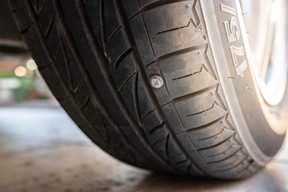A few minutes’ attention can ward off a world of trouble

Article content
Along with the Canadian winter constants of Hockey Night in Canada and flannel shirts, packing up one’s snowmobile and heading to the cottage or cabin is an annual ritual for many Canucks. Not all of us live in a spot where we can hit the trails right from our back door; though, if you can, more power to you. Many hosers will need to either precariously load their snowmobile into the back of a rusty pickup truck or, preferably, secure them on the flat deck of a proper snowmobile trailer.
Advertisement 2
Article content
We’ve spilled plenty of pixels about driving safely while towing a trailer, so we will only give a passing mention to the importance of leaving plenty of stopping distance while towing and maneuvering the conjoined unit with a steadier hand than if the vehicle was solo on the road. Our goal in this article is to focus on a few preventative maintenance items while driving home a solid dose of common sense.
Article content
Got yer helmet ready? Let’s go.
Spring ahead
Let’s start by quickly saying that a trailer owner’s first step in the autumn or winter is often dictated by the last step they took in the spring. If the trailer was simply rolled down that hill behind the garage and left all summer tilted at a jaunty angle, don’t expect the thing to be trouble-free right out of the gate when snow starts flying. If, on the other hand, you took the time to park the snowmobile trailer on level(ish) ground and kept it roughly horizontal with a good quality tongue jack, chances are the trailer will be ready to go when needed.
Advertisement 3
Article content
Squeaky clean

Ok, with those platitudes out of the way, go ahead and give the trailer a good wash and rinse. This will power away any dirt and grime that has accumulated since it was last used, detritus which is sure to go flying into either your snowmobile or another motorist the first time you take it up to speed. Plus, dirt and debris that’s left to fester on the trailer’s deck or in its moving parts can cause premature wear which may lead to an inconvenient breakdown.
How many lights do you see?
Test each of the trailer’s lights for proper function. Do the turn indicators work properly? Are the brake lights illuminating in their intended manner? Replace any unit which is broken or dim, keeping one eye on the overall condition of wiring on the trailer. Any frayed or busted wires should be properly repaired or replaced. Adding the load of extra ‘blinkers’ to the tow vehicle’s electrical system can play havoc in certain situations; if the turn signals flash very quickly instead of at their normal speed, for example, there is a fault in the system somewhere. This could range from a simple blown bulb to a wiring problem.
Advertisement 4
Article content
Feeling tired

Take a look at those rubber donuts sticking out from either side of the trailer’s axle. Is there sufficient tread? Do they exhibit any wear such as cracking or dry rot? Most trailer tires are consumed by the latter long before their tread wears out, owing to the lack of road use compared to a typical car or truck which is used almost every day. Most modern tires will have a four-digit date code, generally stamped on the tire sidewall and enclosed by an oval, that can tell owners the age of their trailer’s tires. The first two digits of the date code is the week (out of 52) in which they were made, and the last two indicate the year. A code 3022 tells us that tire was manufactured in the 30th week of 2022, for example.
Advertisement 5
Article content
Try to steer clear of tires which are old enough to attend school.
Getting your bearings
If possible, safely lift each wheel off the ground (while it is still attached to the trailer’s axle. Why? It is a good idea to attempt spinning and wiggling them by hand, listening for odd noises or sounds before hitting the road for the first time this winter. If the wheel feels as if it is moving through gritty sand, makes a growling-type noise while turning, or wobbles even a tiny bit with a push-pull on either side, a component called a wheel bearing may be worn to the point of needing replacement. This part is responsible for permitting the wheel and tire assembly to spin freely; if worn, it could create a tremendous amount of heat and potentially even start a fire. At worst, the assembly could fail and fall apart, leaving the trailer with one less wheel than it requires — and the driver with a whole handful of problems.
Advertisement 6
Article content
Them’s the brakes

Some trailers over a certain weight have their own braking system to help the tow vehicle slow everything down from speed. Most of these units use electric signals to activate the brakes, but a select few (U-Haul rentals, notably) deploy hydraulics. It is tough to visually inspect these brakes without taking your trailer to a mechanic, but simply eyeballing the area isn’t a bad idea.
If anything seems suspect, call the pros. Better still, having a licensed mechanic give your trailer a clean bill of health at the start of the season is a good plan. We previously mentioned the importance of keeping trailer electrical wiring in top shape, and this is one important reason why. If your tow vehicle is equipped with an electric trailer brake controller, it is a good idea to test the brakes and set their lockup sensitivity before hitting the road.
Stay connected with us on social media platform for instant update click here to join our Twitter, & Facebook
We are now on Telegram. Click here to join our channel (@TechiUpdate) and stay updated with the latest Technology headlines.
For all the latest Automobiles News Click Here






